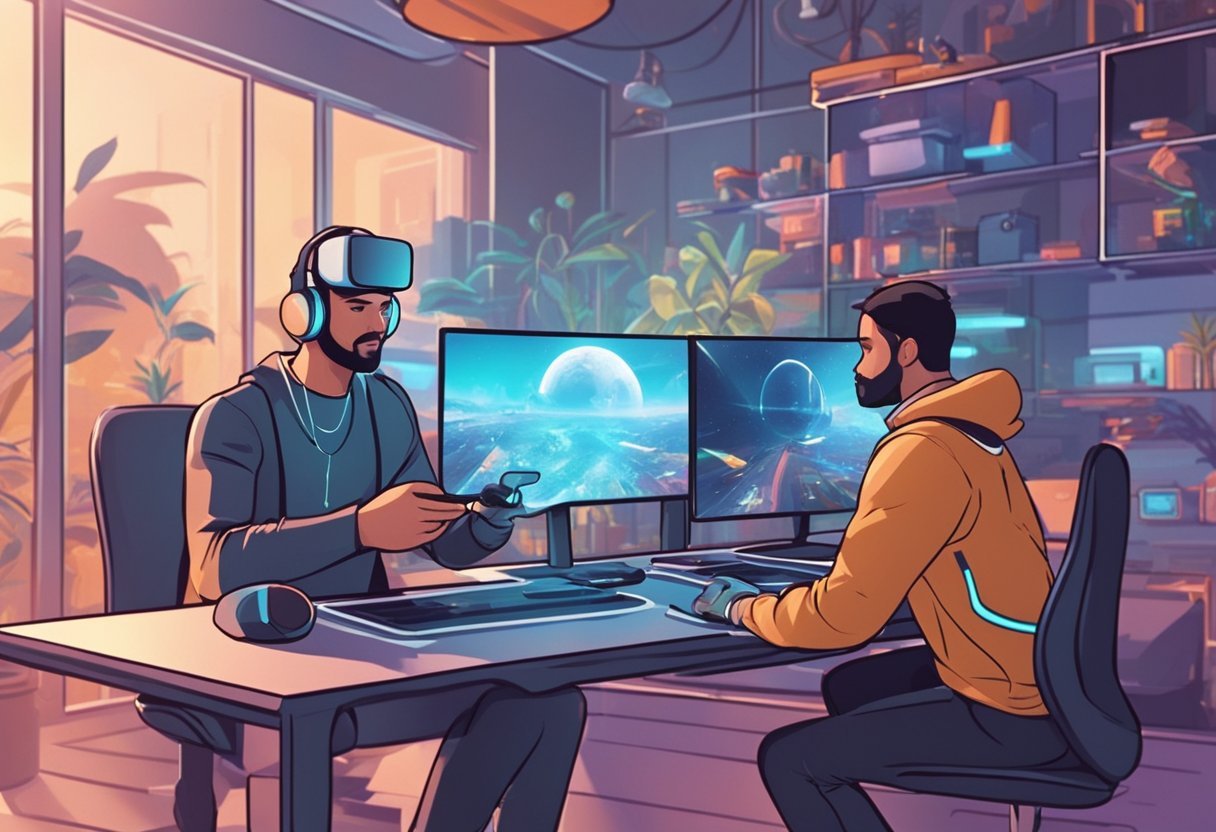Attending classes in the metaverse has become a popular way to stay connected and learn from anywhere. With virtual reality (VR) technology, you can attend lectures, collaborate with other students, and participate in group activities without having to physically be present. This can be particularly helpful during the pandemic when social distancing is necessary. In this guide, we’ll discuss how to attend virtual classes in the metaverse to enjoy all the benefits of a Metaverse classroom.
Key Takeaways:
To attend virtual classes in the Metaverse, you should;
- Get the necessary equipment such as a VR headset and a computer or laptop capable of handling the technology.
- Choose an appropriate course offered in the metaverse.
- Download the associated app and set up your account with personal information.
- Connect with your instructor to get acquainted with how the virtual classroom works and answer any questions you have.
- Participate actively and take notes for future reference.
- Complete assignments, and connect with classmates to form study groups and virtual field trips if possible.
How to Attend Virtual Classes in the Metaverse
Get the Necessary Equipment
The first step to attending classes in the metaverse is to make sure you have all of the necessary equipment. This includes a virtual reality headset and an up-to-date computer or laptop that can handle VR technology.
Choose Your Course
Once you have the equipment, it’s time to choose your course. There are many different courses offered in the metaverse ranging from creative writing to coding and web development.
Download the App
After selecting a course, you’ll need to download the app associated with it. Most apps for virtual classrooms are available on both iOS and Android devices or you can access them through your browser if needed.
Set Up Your Account
Setting up your account is the next step in the process. You’ll need to create a username and password and enter some personal information such as your name, email address, and phone number.
Connect With Your Instructor
Once you have set up your account, it’s time to connect with your instructor. This can be done through the app or by sending an email or text message.
Go Through Orientation
After connecting with your instructor, they will likely run you through an orientation session where they will explain how the virtual classroom works and answer any questions you may have.
Participate Actively
Now that you are ready to start attending your virtual class, make sure to participate actively. Ask questions, join discussions, and stay involved in the course material.
Take Notes
Taking notes is an important part of any online learning experience so make sure to take good notes during your virtual learning space for future reference.
Complete Assignments
Don’t forget to complete all of your assignments on time as this will be crucial for staying on track with the course material in augmented reality.
Connect With Classmates
Finally, don’t forget to connect with your classmates and form study groups and virtual field trips if possible, this can help you stay motivated and focused throughout the course.
What are the Benefits of Virtual Education?
Virtual education has several benefits. Here are some of them:
Immersive Learning
Virtual classes in the metaverse provide an immersive learning experience that allows students to become truly engaged with their course material.
With a VR headset, users can explore the environment around them and interact with elements of the virtual world in real-time.
Collaboration
Virtual classes create a platform for collaboration between students and teachers, allowing both parties to connect more easily and work together more effectively on projects or assignments.
Accessibility
With virtual classes, people from all over the world can attend lectures, seminars, and other learning activities without having to physically be present, making education accessible to everyone regardless of location and unique learning styles.
Flexibility
The flexibility of virtual classes allows students to fit classes around their schedules. Multiple locations, time zones, and languages can be accommodated to ensure everyone has equal access to the same high-quality education.
Variety
The variety of classes offered in the Metaverse is simply unmatched, with courses ranging from creative writing to coding and web development.
Cost
By eliminating travel costs and venue rental fees, virtual classrooms can provide students with an affordable alternative to traditional education.
Interactivity
Virtual classrooms feature various interactive elements such as live polls, quizzes, surveys, and chatbots that help keep students engaged throughout the course material.
Socialization
Through virtual classrooms, students can connect with like-minded peers from all over the world who share similar goals and interests.
Personalization
With virtual learning environments, instructors can tailor their instruction to the individual needs of each student, ensuring that everyone in the class can get the most out of their learning experience. This facilitates deeper understanding of the course material.
Convenience:
One of the biggest advantages of virtual education is that it provides learners with the convenience and flexibility to attend classes from anywhere in the world at any time.
Improved Quality:
Virtual classrooms allow for more collaboration between teachers and students, which can result in improved learning outcomes.
Reduced Overheads:
With virtual classes, course materials can be distributed digitally, eliminating the need to print out physical copies or rent a venue for lectures.
Enhanced Engagement:
The immersive environment created by virtual classrooms encourages active participation among students, making them more engaged with their course material.
Increased Accessibility:
Virtual classes provide access to educational opportunities to those who may not have access to traditional learning environments due to geographic or economic limitations.
Diversity:
Virtual classrooms offer a diverse range of courses designed to suit different needs and interests, allowing students to find the subjects that best fit their goals.
Reduced Environmental Impact:
By eliminating the need for physical textbooks and other materials, virtual classes reduce paper waste and carbon emissions associated with transportation.
Increased Interactivity:
With interactive elements such as polls, quizzes, and chatbots available in virtual classrooms, students can stay engaged and actively involved throughout the course material.
Adaptability:
Virtual classes can be adapted quickly to changes in technology or student needs, making them more flexible than traditional classrooms.
Metaverse Apps for Virtual Classes
Immersive Education
Immersive Metaverse Education is an app that provides high-quality virtual classrooms with engaging visuals, interactive elements, and a variety of courses from creative writing to coding.
ClassVR
ClassVR is an app that offers virtual reality courses in a wide range of subjects such as history, science, math, and technology.
It features immersive 3D environments, collaborative learning, and 360-degree videos to help and engage students throughout the course material.
Best Practice VR
Best Practice VR is an app designed to help and immerse students learn through interactive simulations based on real-life and in-person classroom scenarios.
It allows students to explore different subject areas through virtual environment experiences tailored to their interests and learning needs.
Elevate Learn
Elevate Learn is a virtual space learning platform that provides engaging courses for all levels of learners.
It offers interactive elements such as polls, quizzes, and chatbots to help keep students engaged throughout the course material.
vClassrooms
vClassrooms is an app designed to simulate college-level classes in the metaverse virtual setting. It features immersive environments with high-quality visuals to make learning more fun and engaging for students of all ages.
Labster
Labster is an app designed to provide virtual laboratory experiences in a range of scientific subjects.
Users can explore different scenarios, experiment with various materials, and learn from real scientists within a safe and secure environment.
Kata VR
Kata VR is a virtual reality app that allows students to explore different subject areas through immersive experiences.
It offers courses in various topics such as language, math, and science with real-time interactions between teachers and students.
Nano Learning
Nano Learning is an app designed to empower learners of all ages by providing personalized course content tailored to their needs.
It features interactive elements such as polls, quizzes, and chatbots that help keep students engaged throughout the course material.
Engage3D
Engage3D is an immersive learning platform that provides high-quality 3D environments for educational purposes.
It allows users to explore a variety of subjects through virtual reality simulations ranging from coding to cooking.
Bottom Line
Virtual classes in the metaverse are an exciting way to learn as they provide engaging visuals, interactive elements, and adaptability for any subject.
With the right equipment and a bit of research, anyone can attend virtual classes in the metaverse and find the subjects that best fit their goals.
Be sure to take full advantage of all of the available apps such as Immersive Education, ClassVR, Best Practice VR, Elevate Learn, vClassrooms, Labster, Kata VR, Nano Learning, and Engage3D to help you achieve success.




